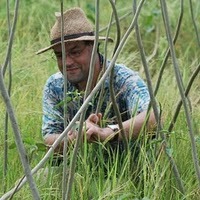
Mario Indelicato
Post Lauream Degree (Scuola di Specializzazione in Beni Archeologici - Catania, 2017. Thesis "Coltivare la vite produrre il vino: un approccio sperimentale e multidisciplinare allo studio dell'Archeologia del vino nella Sicilia romana").
Supervisors: Proff. Massimo Frasca, Daniele Malfitana, and Giuseppe Guzzetta
Master Degree (Laurea Magistrale) Thesis, Università di Catania: "Archeologia del vino in Italia: un esperimento siciliano", Supervisors:
Proff. Daniele Malfitana and Attilio Scienza
Bachelor Degree (Laurea Triennale) Thesis, Università di Catania: "Fornaci antiche - tra emergenze ed etnografia", Supervisor: Prof. Francesco Tomasello
Supervisors: Daniele Malfitana, Attilio Scienza, and Francesco Tomasello
Supervisors: Proff. Massimo Frasca, Daniele Malfitana, and Giuseppe Guzzetta
Master Degree (Laurea Magistrale) Thesis, Università di Catania: "Archeologia del vino in Italia: un esperimento siciliano", Supervisors:
Proff. Daniele Malfitana and Attilio Scienza
Bachelor Degree (Laurea Triennale) Thesis, Università di Catania: "Fornaci antiche - tra emergenze ed etnografia", Supervisor: Prof. Francesco Tomasello
Supervisors: Daniele Malfitana, Attilio Scienza, and Francesco Tomasello
less
Related Authors
Nerissa Russell
Cornell University
Ehab Kamel
University of York
Steven Pinker
Harvard University
Eunice S Nodari
Universidade Federal de Santa Catarina - UFSC (Federal University of Santa Catarina)
Jo Klanovicz
Universidade Estadual do Centro-Oeste
Dorian Q Fuller
University College London
Dan Hicks
University of Oxford
Maurizio Forte
Duke University
Carlos Fabião
Universidade de Lisboa
David Seamon
Kansas State University
InterestsView All (106)










Uploads
Papers by Mario Indelicato
You can find extended version at:
https://exarc.net/issue-2020-1/at/columellas-wine-roman-enology-experiment
Almost twenty years after the conference Archeologie sperimentali: metodologie ed esperienze fra verifica, riproduzione, comunicazione e simulazione in which, perhaps for the first time, experimental archeology applied to the study of human nutrition made its timid entry into the Italian academic debate, it’s appropriate try to evaluate how much this research methodology has been used, within the Italian scientific scenario, in investigations on human sustenance from prehistory to the medieval age. The panel that emerges, starting from the detected case studies, is that of a methodology which, in Italy, still seems in difficult to establish itself in the food archeology field despite being now, at an international level, a consolidated methodology and despite in others countries is successfully applied both to the archeological research tout court and to the ancient food reconstruction also with dissemination objectives.
After a brief overview of the greek and latin heritage on the ‘techincal authors’, or at least containing technical information, and analyzed the ‘medieval filter’, is presented a series of hunts for the use of ancient texts in modern experiments with a look at the archaeological record without forgetting the great contribution of ethnography and ethno-archaeology.
Breve nota informativa sulla prima uva prodotta nella vigna sperimentale nata dal progetto "Archeologia del vino in Italia: un esperimento siciliano" condotto da Mario Indelicato, dall'IBAM - CNR in collaborazione con la cattedra di "Metodologie, cultura materiale e produzioni artigianali nel mondo classico" dell'Università di Catania.
Si tratta di un breve articolo divulgativo sullo Zolfo ed il suo sfruttamento dall'antichità fino ai giorni nostri; con lo sguardo rivolto all'opera di Giovanni Verga si presenta anche una piccola analisi della realtà delle campagne siciliane, in particolare le vigne, di fine ottocento.
Lo scopo è la verifica della fattibilità delle “istruzioni” contenute nei testi degli autori latini (Virgilio e Columella in particolare).
You can find extended version at:
https://exarc.net/issue-2020-1/at/columellas-wine-roman-enology-experiment
Almost twenty years after the conference Archeologie sperimentali: metodologie ed esperienze fra verifica, riproduzione, comunicazione e simulazione in which, perhaps for the first time, experimental archeology applied to the study of human nutrition made its timid entry into the Italian academic debate, it’s appropriate try to evaluate how much this research methodology has been used, within the Italian scientific scenario, in investigations on human sustenance from prehistory to the medieval age. The panel that emerges, starting from the detected case studies, is that of a methodology which, in Italy, still seems in difficult to establish itself in the food archeology field despite being now, at an international level, a consolidated methodology and despite in others countries is successfully applied both to the archeological research tout court and to the ancient food reconstruction also with dissemination objectives.
After a brief overview of the greek and latin heritage on the ‘techincal authors’, or at least containing technical information, and analyzed the ‘medieval filter’, is presented a series of hunts for the use of ancient texts in modern experiments with a look at the archaeological record without forgetting the great contribution of ethnography and ethno-archaeology.
Breve nota informativa sulla prima uva prodotta nella vigna sperimentale nata dal progetto "Archeologia del vino in Italia: un esperimento siciliano" condotto da Mario Indelicato, dall'IBAM - CNR in collaborazione con la cattedra di "Metodologie, cultura materiale e produzioni artigianali nel mondo classico" dell'Università di Catania.
Si tratta di un breve articolo divulgativo sullo Zolfo ed il suo sfruttamento dall'antichità fino ai giorni nostri; con lo sguardo rivolto all'opera di Giovanni Verga si presenta anche una piccola analisi della realtà delle campagne siciliane, in particolare le vigne, di fine ottocento.
Lo scopo è la verifica della fattibilità delle “istruzioni” contenute nei testi degli autori latini (Virgilio e Columella in particolare).
This contribution investigates, to reconstruct, the enology of the Romans (the set of operations that transformed grapes into wine). In fact, the structures necessary for these processes were an important part of Roman farms and villas. Starting from the analysis of the remains excavated in numerous sites in Italy it’s possible to reconstruct various stages of processing. Furthermore, analysis carried out on ceramic materials coming from some production sites allow to reproduce the wine vessels coating techniques and evaluate their efficacy and impact. The archaeological data can be integrated, finally, with the indications of the texts of the Roman agronomists.
Starting from these data, a wine-making experimental protocol was prepared that gave start, in September 2017, to a first-generation experiment completed in April 2018 that could be the basis for subsequent research.
The poster presents a first preliminary overview led by a team of youngs graduate students of the University of Catania. Besides, a particular view of the finds will be possible during the Syracuse session in the ground floor of the Archaeological museum of Syracuse.
The Roman vineyard in Sicily: a spin-off
The project mentioned above is an archaeological experiment that is trying to reproduce experimentally, in Sicily, the Roman techniques of wine production: from the picking of the cuttings up to the harvest. Everything accurately following 'instructions' in the texts of the first century BC Latin Georgics and up to IV AD: in particular the 'De Re Rustica' by Columella. Objective of this study is, in primis, to verify the feasibility of the instructions of ancient agronomists, but also understand if such knowledge may be useful for a better reading of the archaeological record. The most important section of the work is the use of implantation techniques in use of the early Roman Empire. Thanks to the instructions of Columella was possible to identify and reconstruct many agricultural tools, including the 'ciconia'.
In September 2014 was produced the first "Roman" grape and consequently it begins to provide the first "Roman" harvest. For the latter will be needed the wine tanks which will be sealed with pitch. Subject of the posters here this is therefore the study of this substance widely used in the ancient world, but little known by modern.